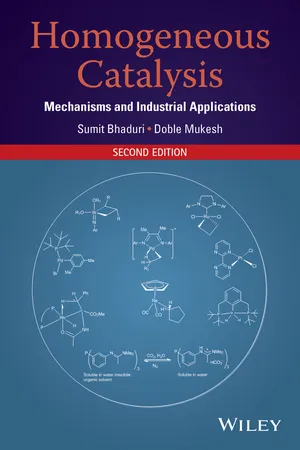
- English
- ePUB (mobile friendly)
- Available on iOS & Android
About this book
Over the last decade, the area of homogeneous catalysis with transition metal has grown in great scientific interest and technological promise, with research in this area earning three Nobel Prizes and filing thousands of patents relating to metallocene and non-metallocene single site catalysts, asymmetric catalysis, carbon-carbon bond forming metathesis and cross coupling reactions.
This text explains these new developments in a unified, cogent, and comprehensible manner while also detailing earlier discoveries and the fundamentals of homogeneous catalysis. Serving as a self-study guide for students and all chemists seeking to gain entry into this field, it can also be used by experienced researchers from both academia and industry for referring to leading state of the art review articles and patents, and also as a quick self-study manual in an area that is outside their immediate expertise. The book features:
•Topics including renewable feed stocks (biofuel, glycerol), carbon dioxide based processes (polycarbonates), fluorous solvents, ionic liquid, hydroformylation, polymerization, oxidation, asymmetric catalysis, and more
•Basic principles of organometallic chemistry, homogeneous catalysis, and relevant technological issues
•Problems and answers, industrial applications (case studies), and examples from proven industrial processes with clear discussions on environmental and techno-commercial issues
•Extensive references to cutting edge research with application potential and leading patents
•Tables and illustrations to help explain difficult concepts
Frequently asked questions
- Essential is ideal for learners and professionals who enjoy exploring a wide range of subjects. Access the Essential Library with 800,000+ trusted titles and best-sellers across business, personal growth, and the humanities. Includes unlimited reading time and Standard Read Aloud voice.
- Complete: Perfect for advanced learners and researchers needing full, unrestricted access. Unlock 1.4M+ books across hundreds of subjects, including academic and specialized titles. The Complete Plan also includes advanced features like Premium Read Aloud and Research Assistant.
Please note we cannot support devices running on iOS 13 and Android 7 or earlier. Learn more about using the app.
Information
Chapter 1
Chemical Industry and Homogeneous Catalysis
1.1 Feedstocks, Fuels, and Catalysts
1.2 Crude Oil to Gasoline and Basic Building Blocks by Heterogeneous Catalysts
Table of contents
- Cover
- Title page
- Copyright page
- Preface
- Chapter 1: Chemical Industry and Homogeneous Catalysis
- Chapter 2: Basic Chemical Concepts
- Chapter 3: Methods of Investigation
- Chapter 4: Carbonylation and Related Reactions
- Chapter 5: Hydrogenation and Other Hydrogen-Based Catalytic Reactions
- Chapter 6: Polymerization and Selective Oligomerization of Alkenes
- Chapter 7: Selective C–C Bond-Forming Reactions with Alkenes
- Chapter 8: Oxidation
- Index
- End User License Agreement